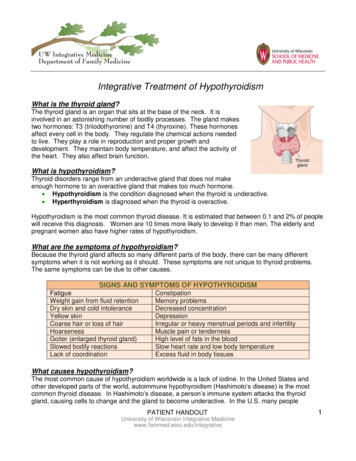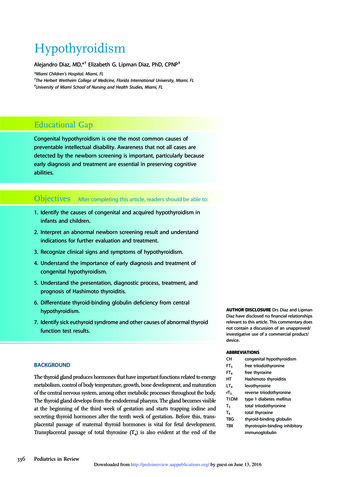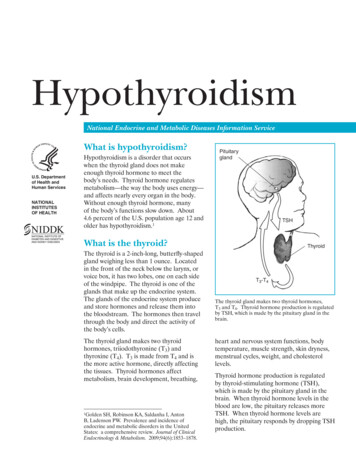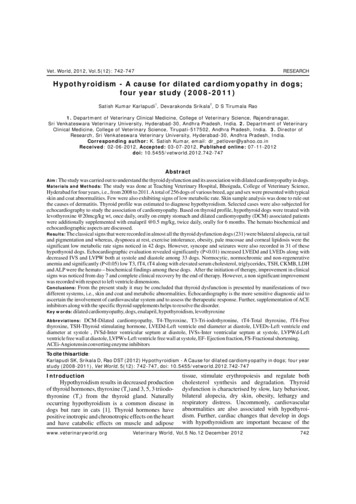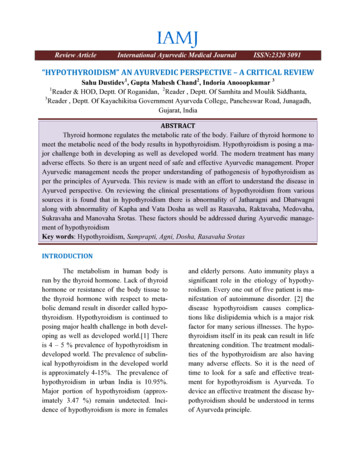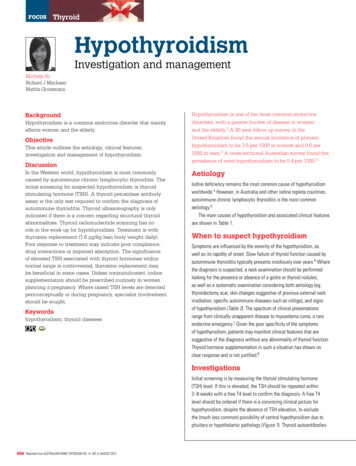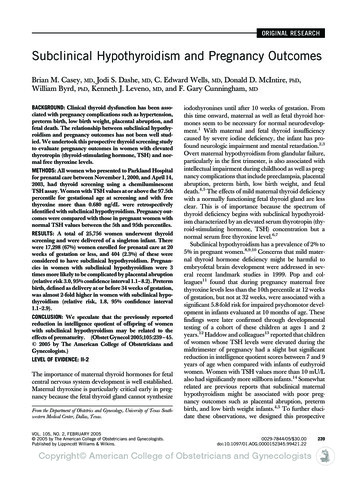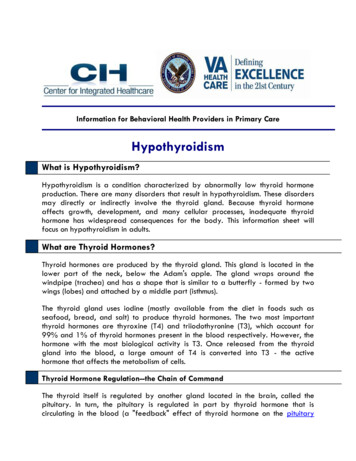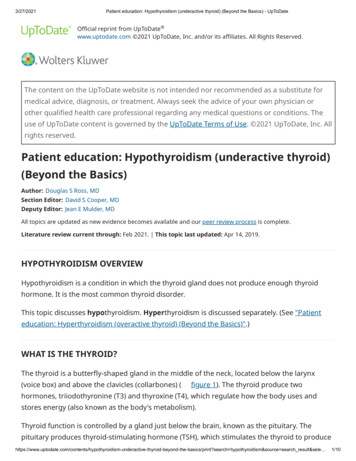
Transcription
3/27/2021Patient education: Hypothyroidism (underactive thyroid) (Beyond the Basics) - UpToDateOfficial reprint from UpToDate www.uptodate.com 2021 UpToDate, Inc. and/or its affiliates. All Rights Reserved.The content on the UpToDate website is not intended nor recommended as a substitute formedical advice, diagnosis, or treatment. Always seek the advice of your own physician orother qualified health care professional regarding any medical questions or conditions. Theuse of UpToDate content is governed by the UpToDate Terms of Use. 2021 UpToDate, Inc. Allrights reserved.Patient education: Hypothyroidism (underactive thyroid)(Beyond the Basics)Author: Douglas S Ross, MDSection Editor: David S Cooper, MDDeputy Editor: Jean E Mulder, MDAll topics are updated as new evidence becomes available and our peer review process is complete.Literature review current through: Feb 2021. This topic last updated: Apr 14, 2019.HYPOTHYROIDISM OVERVIEWHypothyroidism is a condition in which the thyroid gland does not produce enough thyroidhormone. It is the most common thyroid disorder.This topic discusses hypothyroidism. Hyperthyroidism is discussed separately. (See "Patienteducation: Hyperthyroidism (overactive thyroid) (Beyond the Basics)".)WHAT IS THE THYROID?The thyroid is a butterfly-shaped gland in the middle of the neck, located below the larynx(voice box) and above the clavicles (collarbones) (figure 1). The thyroid produce twohormones, triiodothyronine (T3) and thyroxine (T4), which regulate how the body uses andstores energy (also known as the body's metabolism).Thyroid function is controlled by a gland just below the brain, known as the pituitary. Thepituitary produces thyroid-stimulating hormone (TSH), which stimulates the thyroid to search hypothyroidism&source search result&sele 1/10
3/27/2021Patient education: Hypothyroidism (underactive thyroid) (Beyond the Basics) - UpToDateT3 and T4.HYPOTHYROIDISM CAUSESIn approximately 95 percent of cases, hypothyroidism is due to a problem in the thyroid glanditself and is called primary hypothyroidism. However, certain medications and diseases can alsodecrease thyroid function. As an example, hypothyroidism can also develop after medicaltreatments for hyperthyroidism, such as thyroidectomy (surgical removal of the thyroid) orradioactive iodine treatment (to destroy thyroid tissue). In some cases, hypothyroidism is aresult of decreased production of thyroid-stimulating hormone (TSH) by the pituitary gland(called secondary hypothyroidism). (See "Patient education: Hyperthyroidism (overactivethyroid) (Beyond the Basics)".)Thyroid problems are more common in women, increase with age, and (in the United States)are more common in white people and Mexican Americans than in African Americans.HYPOTHYROIDISM SYMPTOMSThe symptoms of hypothyroidism vary widely; some people have no symptoms, while othershave dramatic symptoms or, rarely, life-threatening symptoms. The symptoms ofhypothyroidism are notorious for being nonspecific and for mimicking many of the normalchanges of aging. Usually, symptoms are milder when hypothyroidism develops gradually.Symptoms, when caused by hypothyroidism, generally are related to the degree ofhypothyroidism. Many patients with mild hypothyroidism are identified on screening tests forpotential hypothyroid symptoms but have few or no symptoms that ultimately are attributed tohypothyroidism or respond to treatment of hypothyroidism. In contrast, patients with moderateto severe hypothyroidism are usually symptomatic and improve significantly with thyroidhormone replacement.The following list of symptoms are those that may be present prior to treatment; hypothyroidpatients on appropriate treatment should no longer be symptomatic. If symptoms persist, theylikely have causes other than hypothyroidism.General symptoms — Thyroid hormone normally stimulates the metabolism, and most of thesymptoms of hypothyroidism reflect slowing of metabolic processes. General symptoms mayinclude fatigue, sluggishness, slight weight gain, and intolerance of cold print?search hypothyroidism&source search result&sele 2/10
3/27/2021Patient education: Hypothyroidism (underactive thyroid) (Beyond the Basics) - UpToDateSkin — Hypothyroidism can decrease sweating. The skin may become dry and thick. The hairmay become coarse or thin, eyebrows may disappear, and nails may become brittle.Eyes — Hypothyroidism can lead to mild swelling around the eyes. People who develophypothyroidism after treatment for Graves' disease may retain some of the eye symptoms ofGraves' disease, including protrusion of the eyes, the appearance of staring, and impairedmovement of the eyes. (See "Patient education: Hyperthyroidism (overactive thyroid) (Beyondthe Basics)".)Cardiovascular system — Hypothyroidism slows the heart rate and weakens the heart'scontractions, decreasing its overall function. Related symptoms may include fatigue andshortness of breath with exercise. These symptoms may be more severe in people who alsohave heart disease. In addition, hypothyroidism can cause mild high blood pressure and raiseblood levels of cholesterol.Respiratory system — Hypothyroidism weakens the respiratory muscles and decreases lungfunction. Symptoms can include fatigue, shortness of breath with exercise, and decreasedability to exercise. Hypothyroidism can also lead to swelling of the tongue, hoarse voice, andsleep apnea. Sleep apnea is a condition in which there is intermittent blockage of the airwaywhile sleeping, causing fitful sleep and daytime sleepiness. (See "Patient education: Sleepapnea in adults (Beyond the Basics)".)Gastrointestinal system — Hypothyroidism slows the actions of the digestive tract, causingconstipation. Rarely, the digestive tract may stop moving entirely. (See "Patient education:Constipation in adults (Beyond the Basics)".)Reproductive system — Women with hypothyroidism often have menstrual cycle irregularities,ranging from absent or infrequent periods to very frequent and heavy periods. The menstrualirregularities can make it difficult to become pregnant, and pregnant women withhypothyroidism have an increased risk for miscarriage during early pregnancy. Treatment ofhypothyroidism can decrease these risks. (See "Patient education: Absent or irregular periods(Beyond the Basics)" and "Patient education: Heavy or prolonged menstrual bleeding(menorrhagia) (Beyond the Basics)".)Myxedema coma — In people with severe hypothyroidism, trauma, infection, exposure to thecold, and certain medications can rarely trigger a life-threatening condition called myxedemacoma, which causes a loss of consciousness and hypothermia (low body temperature).HYPOTHYROIDISM t?search hypothyroidism&source search result&sele 3/10
3/27/2021Patient education: Hypothyroidism (underactive thyroid) (Beyond the Basics) - UpToDateIn the past, hypothyroidism was not diagnosed until symptoms had been present for a longtime. However, simple blood tests can now detect hypothyroidism at an early stage. A personmay be tested for hypothyroidism if there are signs and symptoms, such as those discussedabove, or as a screening test.Blood tests — Blood tests can confirm the diagnosis and pinpoint the underlying cause of thethyroid hormone deficiency. The most common blood test for hypothyroidism is thyroidstimulating hormone (TSH). TSH is the most sensitive test because it can be elevated even withsmall decreases in thyroid function. Thyroxine (T4), the main product of the thyroid gland, mayalso be measured to confirm and assess the degree of hypothyroidism. "Overt" hypothyroidismis diagnosed when the TSH is elevated and the T4 is low. "Subclinical" hypothyroidism isdiagnosed when the TSH is elevated but the T4 is normal.Routine screening — All newborn babies in the United States are routinely screened forthyroid hormone deficiency. It is not clear if all adults should be tested for thyroid disease [1].HYPOTHYROIDISM TREATMENTThe goal of treatment for hypothyroidism is to return blood levels of thyroid-stimulatinghormone (TSH) and thyroxine (T4) to the normal range and to alleviate symptoms.Medication — The treatment for hypothyroidism is thyroid hormone replacement therapy. Thisis usually given as an oral form of T4 (levothyroxine). T4 should be taken once per day on anempty stomach (ideally one hour before eating or two hours after; most patients take theirhormone as soon as they wake in the morning, and delay eating breakfast as long as practicalbefore leaving for work or school). Generic (levothyroxine) and brand-name (Synthroid, Levoxyl,Levothroid, Unithyroid) are available as tablets, and gel-caps and liquid preparations are alsoavailable (Tirosint). These formulations are equally effective. However, it is preferable to stay onthe same manufacturer of T4 rather than switching between brand name and/or genericformulations.If a switch is necessary and the patient feels that their levels may be off, a blood test can bedone six weeks later to determine if the dose needs to be adjusted. Color-coded tablets canhelp with dose adjustments.Some clinicians prescribe another form of thyroid hormone, T3 (liothyronine), in combinationwith T4. However, since T4 is converted into triiodothyronine (T3) in other organs, the majorityof studies have not shown an advantage of combination T3 and T4 therapy over T4 earch hypothyroidism&source search result&sele 4/10
3/27/2021Patient education: Hypothyroidism (underactive thyroid) (Beyond the Basics) - UpToDateIn most cases, symptoms of hypothyroidism begin to improve within two weeks of startingthyroid replacement therapy. However, people with more severe symptoms may require severalmonths of treatment before they fully recover.Duration and dose — A health care provider will prescribe an initial dose of T4 and then retestthe blood level of TSH after six weeks. The T4 dose can be adjusted at that time, dependingupon these results. This process may be repeated several times before hormone levels becomenormal. After the optimal dose is identified, a provider may recommend monitoring blood testsonce yearly, or more often as needed. Most people with hypothyroidism require lifelongtreatment, although the dose of T4 may need to be adjusted over time.Never increase or decrease the T4 dose without first consulting a health care provider. Overreplacement of T4 can cause mild hyperthyroidism, with the associated dangers of atrialfibrillation (irregular heart beat) and, possibly, accelerated bone loss (osteoporosis).Dose changes — Changes in the T4 dose are based upon the person's TSH and T4 level. Thedose may need to be increased if thyroid disease worsens, during pregnancy, if gastrointestinalconditions impair T4 absorption, or if the person gains weight. A high-fiber diet, calcium- oraluminum-containing antacids, and iron tablets can interfere with the absorption of T4 andshould be taken at a different time of day.The dose may need to be decreased as the person gets older, after childbirth, or if the personloses weight.Monitoring — Individual T4 doses can vary widely and depend upon a variety of factors,including the underlying cause of hypothyroidism. People with certain conditions require morefrequent monitoring.Advanced age and heart disease — Thyroid hormone makes the heart work a bit harder.Therefore, a clinician may opt for more conservative T4 treatment in older adults and in peoplewith coronary artery disease.Pregnancy — Women often need higher doses of T4 during pregnancy. Testing is usuallyrecommended every four weeks, beginning after conception, until levels are stable, then onceeach trimester. After delivery, the woman's dose of T4 will need to be adjusted again, usuallyreturning to the pre-pregnancy dose.Surgery — Hypothyroidism can increase the risk of certain surgery-related complications;bowel function may be slow to recover, and infection may be overlooked if there is no fever. h hypothyroidism&source search result&sele 5/10
3/27/2021Patient education: Hypothyroidism (underactive thyroid) (Beyond the Basics) - UpToDatepreoperative blood tests reveal low thyroid hormone levels, nonemergency surgery is usuallypostponed until treatment has returned T4 levels to normal.Subclinical hypothyroidism — Subclinical hypothyroidism is when the TSH is elevated but theT4 is normal. The decision to treat subclinical hypothyroidism with T4 is controversial. Patientswith a TSH 10 mU/L are usually treated. The decision to treat patients with a TSH that is abovethe upper limit of normal (this cutoff can vary but is usually around 5 mU/L) but below 10 mU/Lis often based upon age and the presence of goiter (enlargement of the thyroid) or new orworsening symptoms of hypothyroidism. Symptoms can include fatigue, constipation, coldintolerance, or depression. Younger patients (under age 65 to 70 years) are treated more oftenthan older patients.WHERE TO GET MORE INFORMATIONYour health care provider is the best source of information for questions and concerns relatedto your medical problem.This article will be updated as needed on our website (www.uptodate.com/patients). Relatedtopics for patients, as well as selected articles written for health care professionals, are alsoavailable. Some of the most relevant are listed below.Patient level information — UpToDate offers two types of patient education materials.The Basics — The Basics patient education pieces answer the four or five key questions apatient might have about a given condition. These articles are best for patients who want ageneral overview and who prefer short, easy-to-read materials.Patient education: Hypothyroidism (underactive thyroid) (The Basics)Patient education: Hemochromatosis (The Basics)Patient education: Thyroid nodules (The Basics)Patient education: Congenital hypothyroidism (The Basics)Patient education: Hypoparathyroidism (The Basics)Patient education: Panhypopituitarism (The Basics)Patient education: Thyroiditis after pregnancy (The Basics)Patient education: Thyroiditis (The Basics)Beyond the Basics — Beyond the Basics patient education pieces are longer, moresophisticated, and more detailed. These articles are best for patients who want in-depthinformation and are comfortable with some medical search hypothyroidism&source search result&sele 6/10
3/27/2021Patient education: Hypothyroidism (underactive thyroid) (Beyond the Basics) - UpToDatePatient education: Hyperthyroidism (overactive thyroid) (Beyond the Basics)Patient education: Sleep apnea in adults (Beyond the Basics)Patient education: Constipation in adults (Beyond the Basics)Patient education: Absent or irregular periods (Beyond the Basics)Patient education: Heavy or prolonged menstrual bleeding (menorrhagia) (Beyond the Basics)Professional level information — Professional level articles are designed to keep doctors andother health professionals up-to-date on the latest medical findings. These articles arethorough, long, and complex, and they contain multiple references to the research on whichthey are based. Professional level articles are best for people who are comfortable with a lot ofmedical terminology and who want to read the same materials their doctors are reading.Acquired hypothyroidism in childhood and adolescenceCardiovascular effects of hypothyroidismCentral hypothyroidismClinical features and detection of congenital hypothyroidismClinical manifestations of hypothyroidismDiagnosis of and screening for hypothyroidism in nonpregnant adultsDisorders that cause hypothyroidismLaboratory assessment of thyroid functionMyxedema comaNeurologic manifestations of hypothyroidismOverview of thyroid disease and pregnancySubclinical hypothyroidism in nonpregnant adultsTreatment and prognosis of congenital hypothyroidismTreatment of primary hypothyroidism in adultsEndocrinopathies in cancer survivors and others exposed to cytotoxic therapies duringchildhoodThe following organizations also provide reliable health information. National Library of html) The American Thyroid Association(www.thyroid.org) Hormone Health search hypothyroidism&source search result&sele 7/10
3/27/2021Patient education: Hypothyroidism (underactive thyroid) (Beyond the Basics) - hyroid/hypothyroidism)[1,2]Use of UpToDate is subject to the Subscription and License Agreement.REFERENCES1. U.S. Preventive Services Task Force. Screening for thyroid disease: recommendationstatement. Ann Intern Med 2004; 140:125.2. Surks MI, Ortiz E, Daniels GH, et al. Subclinical thyroid disease: scientific review andguidelines for diagnosis and management. JAMA 2004; 291:228.Topic 2179 Version rch hypothyroidism&source search result&sele 8/10
3/27/2021Patient education: Hypothyroidism (underactive thyroid) (Beyond the Basics) - UpToDateGRAPHICSThyroid and parathyroid glandsThe thyroid is a butterfly-shaped gland in the middle of the neck. It sits just below the larynx(voice box). The thyroid makes two hormones, called T3 and T4, which control how the body usesand stores energy. The parathyroid glands are four small glands behind the thyroid. They make ahormone called parathyroid hormone, which helps control the amount of calcium in the blood.T3: triiodothyronine; T4: thyroxine.Graphic 66834 Version ch hypothyroidism&source search result&sele 9/10
3/27/2021Patient education: Hypothyroidism (underactive thyroid) (Beyond the Basics) - UpToDateContributor DisclosuresDouglas S Ross, MD Consultant/Advisory Board: Medullary Thyroid Cancer Registry Consortium [Thyroidcancer]; Spectrix Therapeutics, LLC [Hypothyroidism]; IBSA Pharma Inc [Hypothyroidism]. David S Cooper,MD Nothing to disclose Jean E Mulder, MD Nothing to discloseContributor disclosures are reviewed for conflicts of interest by the editorial group. When found, these areaddressed by vetting through a multi-level review process, and through requirements for references to beprovided to support the content. Appropriately referenced content is required of all authors and mustconform to UpToDate standards of evidence.Conflict of interest policy nderactive-thyroid-beyond-the-basics/print?search hypothyroidism&source search result&sel 10/10
Hypothyroidism can lead to mild swelling around the eyes. People who develop hypothyroidism after treatment for Graves' disease may retain some of the eye symptoms of Graves' disease, including protrusion of the eyes, the appearance of staring, and impaired movement of the eyes. (See "Patient education: Hyperthyroidism (overactive thyroid) (Beyond
